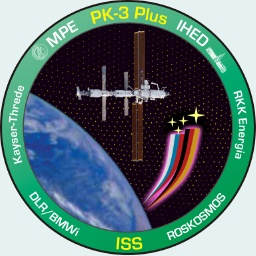|
|
The Evolution of a Project PK-3 Plus, as its precursor PKE-Nefedov, is
a joint Russian/German scientific project. The
collaborating science teams are from the Russian
Academy Institute for High Energy Densities in
Moscow and from MPE. The scientists and engineers from
both institutions have been working since 2002 on the
realisation of PK-3 Plus. In
December 2005 this next-generation
complex plasma experiment facility was launched to
the International Space Station ISS with a russian
Progress cargo spacecraft. First experiments
were performed in January 2006. The science
model, which was tested on two
parabolic flight campaigns is kept with
additional diagnostics at MPE for further
laboratory investigations, and for the planning and
tests of the experiments on board of the ISS.
At the request of ESA, the Russian/German
science team agreed to make PK-3 Plus available
for research to other scientists from ESA, thus
providing much-needed new science impulses to
the community within ESA's interim ISS
utilisation programme.
PK-3 Plus, as its precursor PKE-Nefedov, is
a joint Russian/German scientific project. The
collaborating science teams are from the Russian
Academy Institute for High Energy Densities in
Moscow and from MPE. The scientists and engineers from
both institutions have been working since 2002 on the
realisation of PK-3 Plus. In
December 2005 this next-generation
complex plasma experiment facility was launched to
the International Space Station ISS with a russian
Progress cargo spacecraft. First experiments
were performed in January 2006. The science
model, which was tested on two
parabolic flight campaigns is kept with
additional diagnostics at MPE for further
laboratory investigations, and for the planning and
tests of the experiments on board of the ISS.
At the request of ESA, the Russian/German
science team agreed to make PK-3 Plus available
for research to other scientists from ESA, thus
providing much-needed new science impulses to
the community within ESA's interim ISS
utilisation programme.PK-3 Plus is - like PKE-Nefedov (Fig. 1, click here for a hardware description) - a symmetrical driven radio-frequency plasma discharge with special features for the investigation of complex plasmas under microgravity conditions. As a second generation laboratory, PK-3 Plus provides major new possibilities for these investigations due to its design improvements relative to the first long-term experiment PKE-Nefedov. The PK-3 Plus apparatus allows investigations at neutral gas pressures (Argon and/or Neon) between 0.05 - 2.5 mbar and rf-power of 0.01 - 1 W. The complex plasma can consist of monodisperse particles in a size range from 1 - 20 μm. Up to six particle sizes can be added to the experimental volume. It is possible to change the number of particles, the composition of particles, the plasma conditions and the neutral gas pressure during one experiment. The particle cloud can be excited by an electrical low frequency signal on the electrodes (0.1 - 100 Hz at a maximum amplitude of 50 V) or by a low frequency modulation of the rf-amplitude in different wave forms (sinusoidal, square, pulse, etc.). The ComponentsFig. 2 shows a 3-D drawing of the new plasma chamber. Shown are the basic features of the new plasma chamber design: larger electrodes, dispensers included into the ground shield, a new rf-electronic box allowing many new important housekeeping and experiment measurements and the mounting of the chamber on supporting legs for highest symmetry.
The apparatus is divided into two units, the
experimental block and the Telescience system
(TS), as is PKE-Nefedov. The experimental part
is housed in a closed container with electrical and
vacuum connections to the outside. It contains the
experiment itself, electronics and a computer. An
internal turbomolecular pump has been added to
reach High Vacuum (<10-5 mbar) in the plasma
chamber. This is needed for cleaning the plasma
chamber after long-term storing on the ISS and to
produce very high repeatability of the experiments
due to repeatable experiment parameter settings. A
valve to space is used to reach the necessary prevacuum.
The TS apparatus is the control console for the cosmonaut and allows the storage of the digital and video data. Digital data are available on ground 1 day after the performance of the experiment, the analogue videos are stored on harddrives and have to be transported back via Sojus capsule or the Space Shuttle with the crew change. Quicklook videos are available right after the experimental run and will be transported via S-band and a special hardware (ROKVISS) to the DLR centre in Weilheim. Before performing experiments in orbit the experimental parameters are tested on the science model in Munich and on the equivalent Training Model at IHED. In order to define a sequential measurement an autonomous software procedure is written and uploaded onto the ISS experiment computer. If necessary the cosmonaut can interact or control the experiment by hand via the TS apparatus. Progress en detailThe Major differences compared to the first laboratory (PKE-Nefedov) are:
All of this makes PK-3 Plus an ideal laboratory for
investigating complex plasmas on the ground and
under microgravity conditions. The science model,
which will stay at MPE is fully functioning
and equipped additionally with more diagnostics
and other features. For example, it requires only
slight changes to the plasma chamber and a
temperature gradient can be established between
the lower and the upper electrode allowing particle
levitation of a certain size through the
thermophoretic force. This opens up a broad field
of interesting scientific observations.
|
|
|